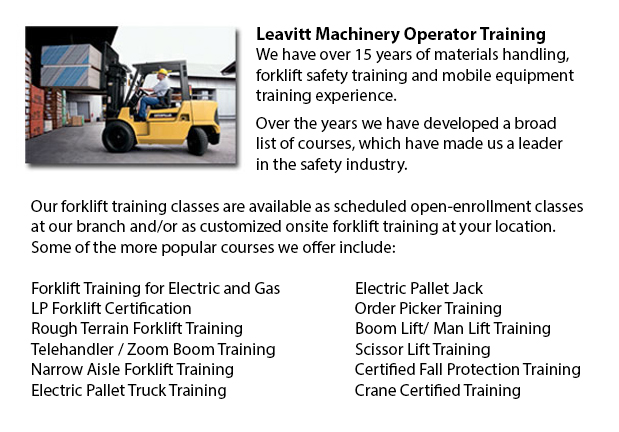
Guelph Forklift Training Schools - Learn How To Operate A Forklift Properly With Our Forklift Training Schools
If you are looking for work as a forklift operator, our regulatory-compliant lift truck training Schools provide exceptional instruction in many types and styles of forklifts, lessons on pre-shift inspection, fuel types and dealing with fuels, and safe utilization of a lift truck. Hands-on, practical training assists people participating in obtaining fundamental operational skills. Course content includes existing rules governing the operation of forklifts. Our proven forklift courses are meant to offer training on these types of trucks: powered pallet truck, narrow isle forklift and counterbalanced forklift.
While the lift truck is in operation, do not lower or raise the forks. Loads should not extend higher than the backrest. This is because of the possibility of the load sliding back in the direction of the operator. Check for overhead obstructions and make sure there is enough clearance before lifting a load. Stay away from overhead power lines. Once the load is raised straight up, tilt it slightly back.
The lift truck is less stable when a load is in a raised position. Make certain that no body ever walks under the elevated fork. The operator must not leave the lift truck while the load is lifted.
The forks must be level when handling pallets, and high enough to extend all the way into and underneath the load. The width of the forks must provide equal distribution of weight.
Chock the wheels and set the brakes before loading and unloading the truck. The floors should be strong enough to support the combined weight of the forklift and its load. Fixed jacks can be installed to support a semi-trailer which is not coupled to a tractor. The entrance door height should clear the forklift height by at least 5 cm. Mark edges of rail cars, ramps or docks and avoid them.
-
Guelph Warehouse Forklift Training Classes
Guelph Warehouse Forklift Training Classes - Warehouse training classes exist for the reason of raising awareness regarding common warehouse hazards. Students learn the important safety procedures that are necessary to warehouse safety. An emphasis i... More -
Guelph Forklift Operator Certification
Guelph Forklift Operator Certification - Certification for forklifts are needed to guarantee the safe use of forklifts for those employers in construction, industrial and warehouse settings. The training has to involve a method of education plus some... More -
Guelph Crane Training School
Guelph Crane Training School - The crane training school offers industry-relevant programs. Courses provide trainees with learning results that match current industry demands. Our small class sizes combine hands-on experience and theory. Our qualifie... More -
Guelph Heavy Equipment Training Programs
Guelph Heavy Equipment Training Programs - At whatever given construction site, there are usually various kinds of machines that are ready to be used. These heavy and light equipment need both operators to run them and mechanics to fix them. Apprenti... More -
Guelph Skid Steer Ticket
Guelph Skid Steer Ticket - On a skid-steer loader, the lift arms are at the side of the driver together with pivot points at the back of the driver's shoulders. This makes them different compared to a traditional front loader. Because of the operator... More -
Guelph Zoom Boom Ticket
Guelph Zoom Boom Ticket - Zoom Boom Training focuses on correctly training prospective operators on variable reach forklifts. The training goals include gaining the understanding of the equipments physics and to define the tasks of the operator. This... More -
Guelph Heavy Equipment Training
Guelph Heavy Equipment Training - Commonly, the different types of heavy equipment training are divided into 2 categories of machinery: those that have rubber tires and tracked vehicles. Tracked vehicles consist of items like for instance bulldozers,... More -
Guelph Aerial Lift Safety Training
Guelph Aerial Lift Safety Training - Each year, there are roughly 26 construction deaths due to the use of aerial lifts. Nearly all of the craftsmen killed are laborers, electrical workers, carpenters, painters or ironworkers. Nearly all deaths are c... More

Forklift Certification Guelph
TOLL FREE: 1-888-254-6157
Guelph, Ontario
forkliftcertificationguelph.com
Email Us
About Us


